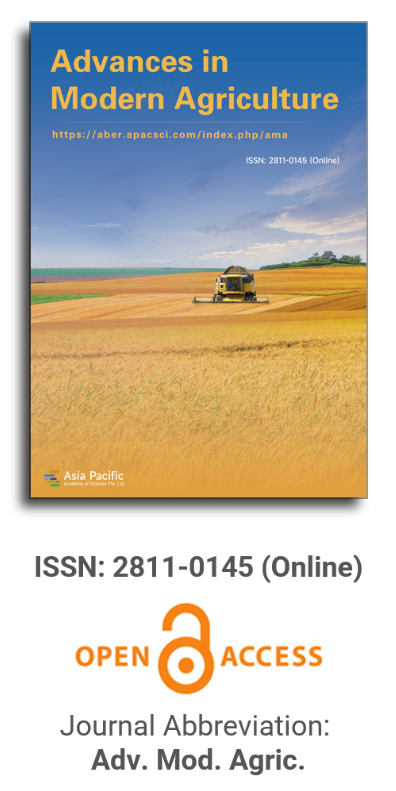


Issue release: 30 September 2025
Evapotranspiration (ET) modeling plays a vital role in water resource management, agriculture, and climate adaptation. Accurate ET prediction is essential for effective irrigation planning and crop management. However, traditional methods often struggle to capture the complex relationships between environmental factors, resulting in less reliable forecasts. To address this, we implemented and optimized the Long Short-Term Memory (LSTM) network model to predict ET with improved accuracy of 98.8%, achieving a Mean Squared Error (MSE) of 0.12. Our approach incorporates SHapley Additive exPlanations (SHAP) to enhance model interpretability, offering insights into how key factors like solar radiation, wind speed, air temperature, and relative humidity impact ET predictions. The results showed that solar radiation had the highest impact on ET, followed by wind speed and air temperature. This improved understanding of key factors can help farmers and water managers make better decisions about irrigation, ensuring efficient water use and supporting sustainable agriculture. This provides a reliable and interpretable solution for ET prediction, aiding smarter irrigation strategies, improving resource efficiency, and supporting sustainable agricultural practices.
Issue release: 30 September 2025
This study aimed to determine the perceived effects of climate change on the livelihoods of farming communities in the semi-arid regions of southwestern Zimbabwe. A qualitative approach was used to investigate smallholder farmers’ views and experiences regarding climate change and its impacts in two wards in the Tsholotsho district, Matabeleland North province, Zimbabwe. The primary data collection methods were key informant interviews and focus-group discussions. Participants were selected using purposive sampling from established farmer groups in the study area. Most focus group discussion participants agreed that they were aware of and experienced climate-related risks in their community. They observed climate variability, particularly in the occurrence of extreme events, such as drought and insufficient rainfall, including mid-season dry spells. The 2023/2024 season was marked by very low rainfall, mid-season dry spells, and challenges to crop sustainability. Smallholder farmers in the study area indicated that they were experiencing crop failure, livestock mortality, and reduced crop yields, all of which contribute to declining agricultural productivity. In response to drought, smallholder farmers primarily employed coping strategies, such as land management through Pfumvudza, a conservation land management coping strategy; crop diversification; the use of drought-tolerant crops that are early maturing; and seeking alternative non-farming income sources.
Issue release: 30 September 2025
Body weight estimation accuracy is key to efficient sheep management and improved animal performance. This study investigated sex-based differences in the correlation between body weight (BWT) and linear body measurements (LBM) in indigenous Sabi sheep. A dataset comprising 173 Sabi sheep (112 ewes, 22 rams, and 39 wethers) from Zimbabwe’s Matopos Research Institute was analyzed, revealing significant positive correlations between body weight and linear measurements, particularly in ewes and rams. Heart girth exhibited the strongest positive correlation with body weight across sexes, with rams demonstrating higher correlation coefficients than ewes. Notably, body length in rams (r = 0.90) had a significantly higher correlation coefficient with body weight compared to ewes (r = 0.79). Conversely, weaker correlations were observed for Thurl width and pin bone width in wethers. The study identified sex-based differences in the relationships between body weight and linear measurements, indicating sexual dimorphism. Heart girth, body length, and chest depth emerged as key predictors of body weight in indigenous Sabi sheep. These findings underscore the importance of considering sex in understanding the relationship between body weight and linear body measurements in this breed, with implications for enhancing breeding programs and management practices for indigenous Sabi sheep. In conclusion, this study emphasizes the necessity of sex-specific data analysis when examining the correlation between body weight and linear body measurements in indigenous Sabi sheep to ensure accurate and reliable results.

Prof. Zhengjun Qiu
Zhejiang University, China

Cheng Sun
Academician of World Academy of Productivity Science; Executive Chairman, World Confederation of Productivity Science China Chapter, China
Indexing & Archiving
In the realm of modern agriculture, the integration of cutting-edge technologies is revolutionizing the way we approach sustainable farming practices. A recent study published in Advances in Modern Agriculture titled "Classification of cotton water stress using convolutional neural networks and UAV-based RGB imagery" has garnered significant attention for its innovative approach to precision irrigation management. Conducted by researchers from Institute of Data Science and the AgriLife Research and Extension Center of Texas A&M University (authors's information is below). This study introduces a novel method for classifying cotton water stress using unmanned aerial vehicles (UAVs) and convolutional neural networks (CNNs), offering a powerful solution for optimizing water use in agriculture.
Modern agricultural technology is evolving rapidly, with scientists collaborating with leading agricultural enterprises to develop intelligent management practices. These practices utilize advanced systems that provide tailored fertilization and treatment options for large-scale land management.
This journal values human initiative and intelligence, and the employment of AI technologies to write papers that replace the human mind is expressly prohibited. When there is a suspicious submission that uses AI tools to quickly piece together and generate research results, the editorial board of the journal will reject the article, and all journals under the publisher's umbrella will prohibit all authors from submitting their articles.
Readers and authors are asked to exercise caution and strictly adhere to the journal's policy regarding the usage of Artificial Intelligence Generated Content (AIGC) tools.
Asia Pacific Academy of Science Pte. Ltd. (APACSCI) specializes in international journal publishing. APACSCI adopts the open access publishing model and provides an important communication bridge for academic groups whose interest fields include engineering, technology, medicine, computer, mathematics, agriculture and forestry, and environment.


 Open Access
Open Access

.jpg)
.jpg)

.jpg)
